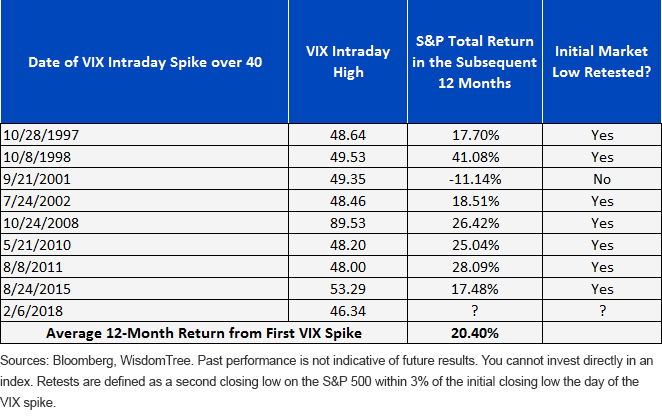Those who were home last week with the flu may have missed the stock market’s equivalent of a lunar eclipse. The Volatility Index (VIX), a measure of market fear, briefly spiked above 50 on Tuesday, February 6—marking only the third time in the last 20 years that this index has soared to that level.
The Dow Jones Industrial Average oscillated within a 2,500-point range between Thursday, February 1, and Tuesday, February 6. In a typical correction, market sell-offs can take weeks or months to unfold. But in today’s environment, a 10% correction can be completed in a matter of hours—and that’s exactly what many investors endured as January turned into February.
What caused the sell-off, and what does it mean for potential returns going forward?
Let me address, first, what has happened historically in the 12 months following a VIX spike. The last time I wrote about this subject, back in October 2015, I showed that in the seven instances where the VIX reached intraday levels above 40 going back to 1997, the S&P 500 returned more than a 20% average return in the subsequent 12 months. And in the year after that most recent August 2015 VIX spike, the S&P 500 returned 17.5%—raising the historical odds for an above-average market return to 88% in the 12 months following a VIX spike.

So, was the recent sell-off a healthy pause—a heart palpitation that reminds you to take your aspirin, exercise and trim some weight? Or was it the first sign that the market may be headed for a more prolonged cardiac arrest?
No one knows with perfect certainty why sudden sell-offs occur, as financial markets reflect the judgments of millions of independent factors. But by observing some of the symptoms, we can get closer to a diagnosis.
First, the sudden move higher in 10-Year Treasury yields likely played a role. Rising long-term interest rates cause assets to be repriced. For stocks, this typically means contractions in P/E ratios. While higher rates may also suggest higher economic growth, which is good for corporate sales growth, higher rates may also be the market’s response to higher wages and rising labor costs, which ultimately can squeeze corporate profit margins. We don’t expect to see any decay in corporate earnings this quarter (more than 80% of the 250 S&P 500 companies that have reported fourth-quarter earnings have beaten consensus estimates1). But going forward, higher government and corporate bond yields can create competition for stocks. With yields on the 10-Year Treasury north of 2.80% (nearly 100 basis points (bps) higher than the dividend yield on the S&P 500), rising rates not only add interest costs to companies and governments, they compete for the new money being put to work by investors. Rising short-term interest rates make buying stocks on margin less appealing. Given that debit balances in customer securities accounts surged to a seven-year high in 2017, sharp market pullbacks can trigger margin calls that can create a second wave of forced selling, which may help to explain part of February 8th 1,000-point drop in the Dow.


















Leave A Comment